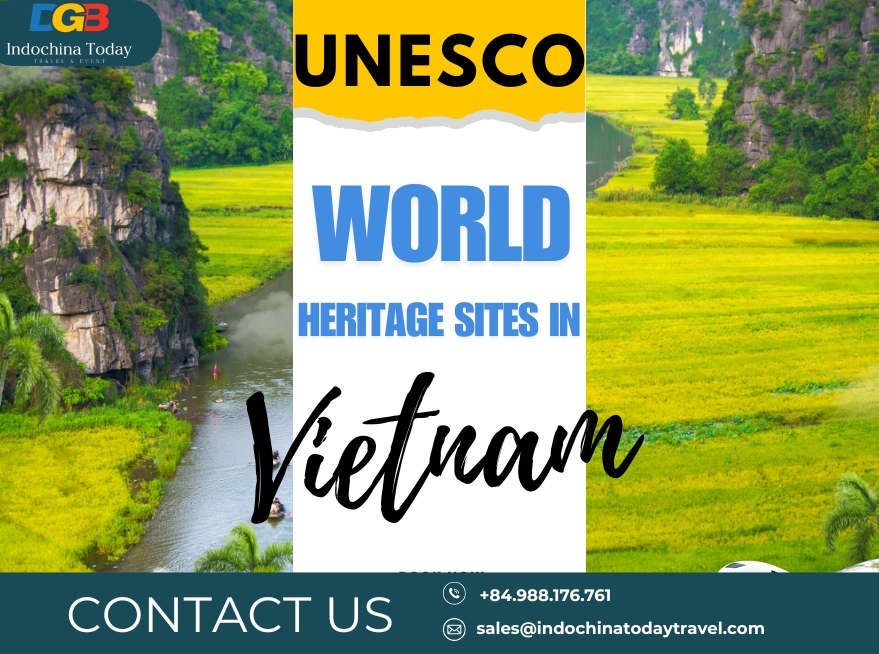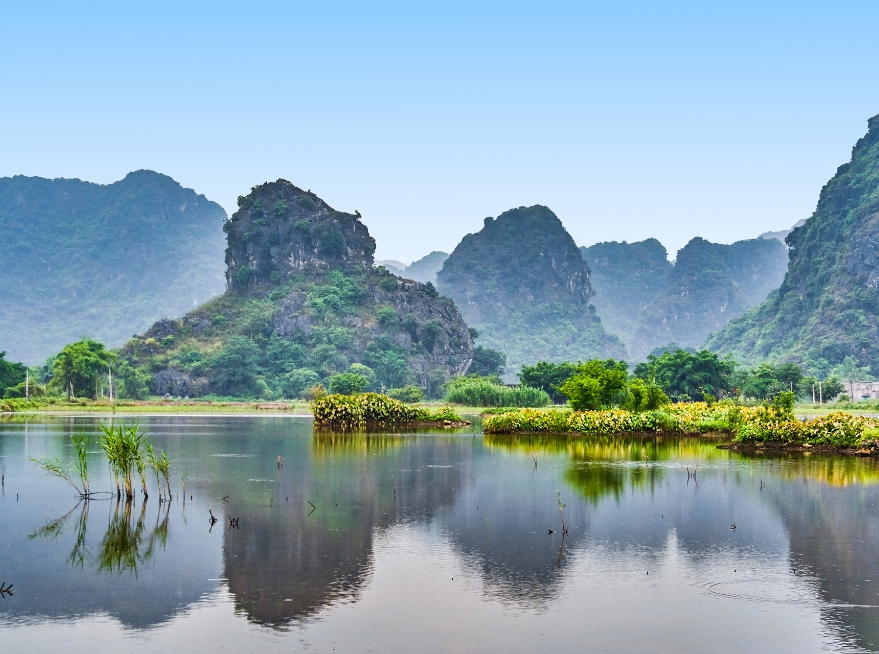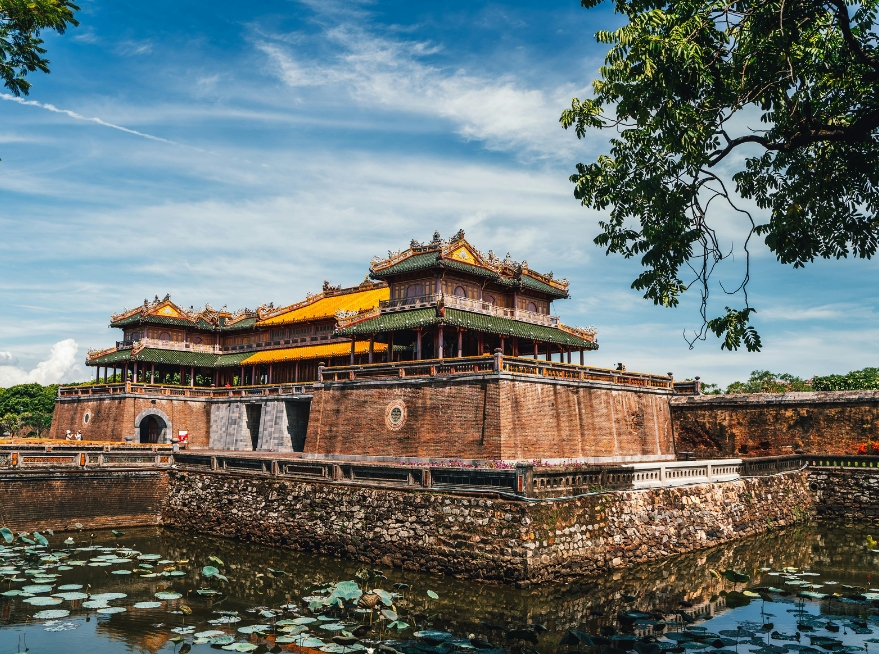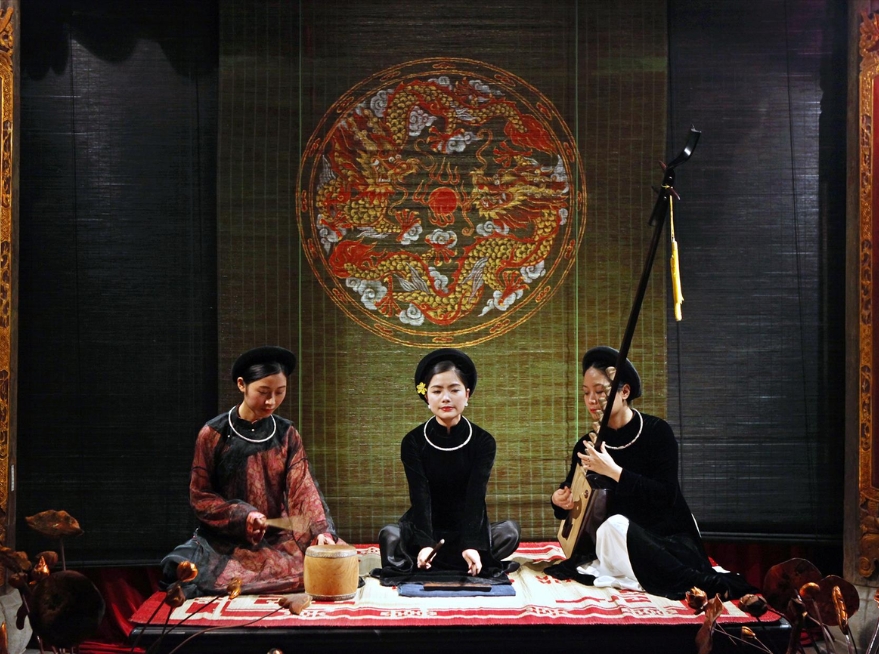Vietnam, a land of breathtaking landscapes and a deep-rooted cultural legacy, is home to numerous treasures recognized globally for their significance. Among these, the UNESCO World Heritage Sites in Vietnam stand out as iconic symbols of the country’s diverse heritage. These sites span ancient citadels, spiritual complexes, unique natural formations, and traditional cultural practices. Join Indochina Today Travel as we guide you through a journey of discovery to explore these globally celebrated landmarks.

Understanding the Value of UNESCO World Heritage Sites
UNESCO World Heritage Sites represent the pinnacle of global recognition for locations that possess exceptional cultural, historical, scientific, or natural significance. Established by the United Nations Educational, Scientific and Cultural Organization (UNESCO), the World Heritage program aims to identify, protect, and preserve places deemed important to the collective interests of humanity. These are sites that transcend national boundaries, serving as invaluable chapters in the story of civilization and the natural world.
To qualify for inclusion, a site must meet at least one of ten stringent criteria outlined by UNESCO. These criteria are designed to ensure that each listed property holds outstanding universal value. This could be in the form of architectural excellence, artistic influence, natural beauty, or ecological significance. Moreover, each site must demonstrate authenticity, integrity, and a robust system of protection and management to safeguard its preservation over time.
When it comes to the UNESCO World Heritage Sites in Vietnam, the value goes far beyond aesthetics or tourism appeal. These locations are living testaments to the country’s dynamic history, cultural identity, and natural grandeur. They encapsulate thousands of years of human endeavor, resilience, and spirituality—from ancient dynastic capitals and sacred temples to dramatic karst landscapes and biodiverse national parks.
What makes the UNESCO World Heritage Sites in Vietnam particularly unique is how they intertwine cultural heritage with natural splendor. For example, the Imperial Citadel of Thang Long in Hanoi reflects the military and political might of ancient Vietnam, while Ha Long Bay in the northeast stirs awe with its towering limestone pillars and serene waters, shaped over millions of years by geological forces.
These sites are not only significant for Vietnam, but they also hold global relevance. They provide insights into the development of human civilization in Southeast Asia, illustrate humanity’s relationship with nature, and contribute to worldwide discussions on conservation, cultural preservation, and sustainable development. Their value lies not just in their ability to attract visitors, but in their role as educational and spiritual touchstones for future generations.
Furthermore, the recognition of these locations as UNESCO World Heritage Sites helps catalyze national pride and international cooperation. It encourages Vietnam to invest in heritage preservation, environmental conservation, and cultural education, ensuring that the legacy of these sites continues to inspire and enlighten for centuries to come.
In essence, the UNESCO World Heritage Sites in Vietnam embody the intersection of memory, identity, and nature. They invite travelers not just to witness history, but to walk through it—to listen to the echoes of ancient dynasties, feel the pulse of traditional life, and embrace the shared responsibility of protecting our world’s most precious treasures.
Cultural Sites in Northern Vietnam
The Central Sector of the Imperial Citadel of Thang Long – Hanoi
Located in the heart of the capital city, this historical complex served as the political center of Vietnam for thirteen consecutive centuries. Constructed during the Ly Dynasty in the 11th century, the citadel showcases the fusion of ancient Vietnamese culture with Southeast Asian and Chinese influences. Archeological findings reveal intricate designs, architectural marvels, and historical artifacts that narrate the story of Vietnam’s royal past.
Exploring the Citadel provides an immersive experience into the grandeur of Vietnamese dynasties and their interactions with neighboring cultures. Visitors can witness restored gates, ancient foundations, and exhibitions that demonstrate the citadel’s historical significance as one of the UNESCO World Heritage Sites in Vietnam.
Trang An Landscape Complex – Ninh Binh

The Trang An Landscape Complex is a harmonious blend of cultural and natural heritage. This vast area comprises limestone karst peaks, caves, and sacred temples nestled within tranquil waterways. It’s often referred to as “Halong Bay on land” due to its dramatic scenery.
What sets Trang An apart is its archeological and historical relevance. Human remains and tools dating back 30,000 years have been discovered here, suggesting continuous habitation. The ancient capital of Hoa Lu and several pagodas within the complex offer insight into the region’s religious and cultural practices. It is a profound example of how humans have coexisted with nature for millennia, and its recognition as one of the UNESCO World Heritage Sites in Vietnam confirms its universal value.
Central Vietnam: The Heart of Heritage
The Complex of Hue Monuments – Thua Thien Hue Province
Hue was once the imperial capital of the Nguyen Dynasty and remains a symbol of national pride. The Complex of Hue Monuments includes the Imperial City, royal tombs, temples, and ceremonial structures laid out in accordance with traditional geomantic principles.
Walking through the citadel’s moats and corridors, visitors feel transported to a time of dynastic rule, spiritual observance, and refined artistry. The harmonious integration of architecture and natural landscapes illustrates Vietnam’s deep respect for spiritual and environmental balance. This site was Vietnam’s first property inscribed on the World Heritage List and remains a centerpiece of cultural tourism.
Hoi An Ancient Town – Quang Nam Province

Once a bustling trading port between the 15th and 19th centuries, Hoi An is a living museum of Southeast Asian trading culture. With its narrow lanes, preserved wooden architecture, traditional houses, and heritage temples, Hoi An exemplifies the unique blend of indigenous and foreign influences, including Chinese, Japanese, and European.
Strolling through Hoi An’s lantern-lit streets offers a serene experience, where past and present coalesce. Local artisans, traditional performances, and culinary experiences breathe life into the town’s ancient soul. Recognized among the UNESCO World Heritage Sites in Vietnam, Hoi An continues to enchant both scholars and travelers alike.
My Son Sanctuary – Quang Nam Province
My Son Sanctuary is a cluster of Hindu temple ruins built by the Champa civilization between the 4th and 13th centuries. Nestled in a valley surrounded by mountains, the sanctuary served as a religious center dedicated to the god Shiva. The architectural remains are a testimony to the Champa Kingdom’s spiritual and political life.
Despite damage during wars, many towers and intricate carvings still stand, echoing the glory of a forgotten empire. My Son not only highlights the cultural exchange between Indian and Southeast Asian civilizations but also symbolizes resilience and historical importance. It is undeniably one of the most spiritual of the UNESCO World Heritage Sites in Vietnam.
The Natural Marvels of Vietnam
Phong Nha – Ke Bang National Park – Quang Binh Province
Located in Central Vietnam, this national park is a geological wonder featuring the world’s oldest karst mountains, formed over 400 million years ago. The park contains hundreds of caves and grottoes, including Son Doong, the largest cave in the world.
Phong Nha – Ke Bang is significant not only for its size and beauty but also for its ecological richness. The limestone formations, underground rivers, and forested mountains create a complex ecosystem that supports rare flora and fauna. Adventure seekers, spelunkers, and nature lovers consider this site a paradise. Its designation as one of the UNESCO World Heritage Sites in Vietnam is a testament to its scientific and natural importance.
The Iconic Wonder of Northern Vietnam
Ha Long Bay – Quang Ninh Province
Ha Long Bay is undoubtedly one of the most recognized UNESCO World Heritage Sites in Vietnam. With over 1,600 limestone islands and islets rising from emerald waters, the bay creates a seascape of towering karsts that captivate every visitor.
Declared a UNESCO World Heritage Site for both its geological and aesthetic value, Ha Long Bay tells a story of Earth’s history through its unique formations. Some of these islets are hollow, containing majestic caves with stalactites and stalagmites shaped by nature over millennia.
Beyond its natural beauty, the bay holds cultural meaning as well. Local legends speak of dragons descending to protect the land, a myth that adds mystique to the destination. Cruising through the bay, visitors can explore floating fishing villages, kayak through hidden lagoons, or climb to viewpoints that offer unforgettable panoramic views. Ha Long Bay remains a shining example of why the UNESCO World Heritage Sites in Vietnam are treasured worldwide.
Intangible Cultural Heritage Recognized by UNESCO
While most think of physical landmarks, Vietnam is also home to intangible cultural heritage elements that UNESCO has recognized. These practices are vital expressions of human creativity and cultural identity, preserved and passed down through generations.
Ca Tru Singing

Ca Tru is an ancient genre of Vietnamese chamber music. Traditionally performed in royal courts and private homes, it involves poetic lyrics, string instruments, and a delicate vocal technique. Performances are intimate, reflecting themes of love, philosophy, and nature.
Today, Ca Tru is performed at cultural venues in Hanoi and a few northern provinces. Efforts to preserve and revitalize this art form have led to increased public awareness. Ca Tru’s inclusion as one of the UNESCO World Heritage Sites in Vietnam in the intangible category ensures its continued relevance in modern Vietnamese society.
Xoan Singing of Phu Tho
Xoan singing, a ritual performance that blends music, dance, and poetry, is associated with the worship of the Hung Kings in Phu Tho Province. It is typically performed in communal houses during festivals and has deep roots in spiritual beliefs and agricultural life.
The Xoan singing tradition faced the risk of extinction but has seen a revival thanks to community-led efforts and state support. Its recognition as a part of the UNESCO World Heritage Sites in Vietnam has helped preserve its cultural significance and elevate it to global appreciation.
Preserving the Legacy of Vietnam’s Heritage
Vietnam’s UNESCO sites are more than tourist attractions—they are living embodiments of the nation’s soul. However, preserving these sites is a complex task that requires collaboration between government authorities, local communities, and visitors.
Sustainable Tourism Practices
As tourism grows, sustainable practices become crucial. Visitors to the UNESCO World Heritage Sites in Vietnam are encouraged to respect local customs, avoid damaging natural environments, and support local economies by choosing eco-friendly tours.
For instance, limiting boat traffic in Ha Long Bay and regulating cave access in Phong Nha – Ke Bang help protect delicate ecosystems. In historical towns like Hoi An, preserving the authenticity of buildings and promoting traditional crafts ensures that tourism enhances rather than erodes cultural values.
Community Involvement
One of the most effective preservation strategies is involving local communities in site management. Many residents serve as tour guides, artisans, or caretakers of these sites, offering authentic experiences while fostering a sense of ownership and pride.
In places like Trang An and My Son, local guides often provide personal stories and insights that enrich the visitor’s understanding. Supporting community-led initiatives ensures that these UNESCO World Heritage Sites in Vietnam continue to thrive for future generations.
Planning Your Cultural Journey with Indochina Today Travel
If you’re looking to explore these incredible destinations, Indochina Today Travel offers expertly curated tours to every corner of Vietnam. Our guides are passionate about heritage and deeply knowledgeable about each site’s historical and cultural significance.
Why Choose Indochina Today Travel?
When it comes to discovering the most meaningful and unforgettable UNESCO World Heritage Sites in Vietnam, having the right travel partner can make all the difference. At Indochina Today Travel, we don’t just organize trips—we curate immersive cultural journeys that connect you deeply with Vietnam’s rich heritage, breathtaking landscapes, and authentic local experiences.
Local Expertise That Brings History to Life
One of our greatest strengths lies in our people. Our team is made up of seasoned professionals with deep-rooted knowledge and passion for Vietnamese history, culture, and geography. From cultural historians and archaeologists to expert tour guides who have walked these ancient paths for decades, our staff ensures that every step of your journey is enriched with stories, context, and insight.
When you visit the UNESCO World Heritage Sites in Vietnam—whether it’s the ancient town of Hoi An, the Imperial Citadel of Hue, or the dramatic caves of Phong Nha—our guides offer more than just facts. They breathe life into these places, sharing legends, historical milestones, and personal anecdotes that allow you to experience each site as more than just a destination, but a living legacy.
Tailored Itineraries for Every Kind of Explorer
At Indochina Today Travel, we understand that no two travelers are alike. Some are drawn to the serenity of nature, others to the pages of history or the vibrancy of living traditions. That’s why we specialize in crafting custom itineraries that match your personal interests, travel pace, and preferred level of engagement.
Whether you dream of cruising through Ha Long Bay at sunrise, exploring the temples of My Son Sanctuary, or joining a hands-on cultural workshop in a heritage village, we work with you to design a journey that is entirely your own. Our curated experiences include luxury options, adventure treks, culinary tours, family-friendly routes, and in-depth cultural explorations—all designed with care and attention to detail.
A Commitment to Sustainable and Responsible Travel
Our responsibility doesn’t end at creating memorable journeys. We are committed to promoting sustainable tourism practices that benefit both the environment and the communities we visit. Many of the UNESCO World Heritage Sites in Vietnam are living spaces for local people—not just preserved landmarks. We believe that tourism should uplift, not disrupt.
That’s why we collaborate with local artisans, homestay owners, eco-tourism initiatives, and community leaders to ensure your travel has a positive impact. We limit group sizes, reduce waste, respect local customs, and support efforts to conserve natural and cultural resources.
Your Gateway to Vietnam’s Greatest Treasures
From the bustling streets of Hanoi to the imperial grandeur of Hue, the timeless charm of Hoi An to the surreal beauty of Ha Long Bay—Indochina Today Travel is your trusted companion in exploring the UNESCO World Heritage Sites in Vietnam. With us, you won’t just see Vietnam. You’ll feel its soul.
Final Thoughts
Vietnam’s recognition on the world stage through its UNESCO sites is not only a point of national pride but also a profound invitation to all travelers. These places serve as bridges between past and present, nature and humanity, the local and the global.
Whether it’s the grandeur of the Imperial Citadel of Thang Long, the serene beauty of Trang An, or the mysticism of My Son Sanctuary, each site offers a unique window into Vietnam’s multifaceted heritage. And with the inclusion of intangible cultural elements like Ca Tru and Xoan singing, the story becomes even richer.
As you plan your journey, remember that these UNESCO World Heritage Sites in Vietnam are not just to be seen—they are to be felt, understood, and respected. Let Indochina Today Travel be your companion in this cultural voyage, helping you connect deeply with Vietnam’s most treasured stories.
See more: Book Your Exclusive Private Tours to Vietnam Today!
Add: Suite E2-0916, Ecohome Phuc Loi Building, Phuc Loi St., Long Bien Dist., Hanoi, Vietnam
Hotline / WhatsApp: +84.988.176.761
Email: sales@indochinatodaytravel.com
Phone: +84.24.6685.5566
Website: indochinatodaytravel.com | dgbtravel.com | vietnamgolflux.com

